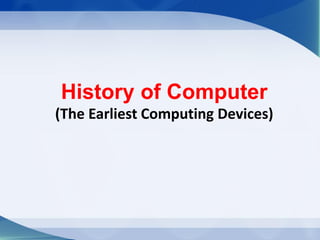
IS-101-4-History-of-Computers.pdfshhhsshs
- 1. History of Computer (The Earliest Computing Devices)
- 2. ➢Abacus is known to be the first mechanical calculating device. ➢It was used to be performed addition and subtraction easily and speedily. ➢ This device was a first develop by the Egyptians in the 10th centaury B.C, but it was given it final shape in the 12th centaury A.D. by the Chinese educationists. Abacus
- 3. Abacus ➢Abacus is made up of wooden frame in which rod where fitted across with rounds beads sliding on the rod. It is divided into two parts called ‘Heaven’ and ‘Earth’. ➢Heaven was the upper part and Earth was the lower one. Thus any nunmber can be represented by placing the beads at proper place. ➢There are two reasong for its popularity: The abacus is simple and it is effective.
- 4. ➢As the necessity demanded, scientist started inventing better calculating device. In thus process John Napier’s of Scotland invented a calculating device, in the year 1617 called the Napier Bones. In the device, Napier’s used the bone rods of the counting purpose where some no. is printed on these rods. These rods that one can do addition, subtraction, multiplication and division easily. Napier’s Bones
- 5. ➢John Napier was a Scottish mathematician who became famous for his invention of logarithms. The use of “logs” enabled him to reduce any multiplication problem to a problem of addition. ➢His “bones” are rods with numbers marked on them in such a way that by simply placing the rods side by side products and quotients of large numbers can be obtained. ➢The sticks were called “bones” because they were made of bone or ivory. Napier’s “bones” represented a significant contribution to the development of computing devices. Napier’s Bones
- 7. ➢ Although the slide rule appeared in various forms in Europe during the seventeenth century, its invention is attributed to the English mathematician William Outhred. ➢ Basically, a slide rule consists of two movable rulers placed side by side. ➢ Each ruler is marked off in such a way that the actual distances from the beginning of the ruler are proportional tot he logartihms of the numbers printed on the ruler. By sliding the rulers can quickly multiple and divide. Oughtred’s Slide Rule
- 9. ➢ In 1645, Blaise Pascal developed a calculating machine that was capable of adding and subtracting numbers. ➢ The machine was operated by dialing a series of wheels. ➢ Approximately a size of a cigar box, Pascal’s machine could add and subtract numbers containing up to eight digits. ➢ It had a 10-toothed wheels or dials represented decimal numbers. The machine performed computations by counting integers. One of the important features was an automatic carry that is, when one wheel was turned from 9 to 0, the next wheel to the left moved on digit. ➢ Addition was performed by “stepping” (hand turning) the appropriate wheels by the amount to be added. Subtraction require turning the wheels in reverse. Pascal’s Calculator
- 11. Leibniz’s Calculator ➢ Gottfried Leibniz was a 17th century scientist who recognized the value of building machines that could do mathematical calculations and save labor too. ➢ He was one of the greatest scientific geniuses of his time. At the age of 26 he taught himself mathematics and then proceeded to invent calculus. ➢ Leibniz completed his calculator in 1964. It utilized the same techniques for addition and subtraction as Pascal’s device but could also perform multiplication and division, as well as extract square roots.
- 13. Babbage’s Analytical Engine ➢ Charles Babbage, a 19th century Englishman, is frerquently consideres the father of modern computer. Althugh he did not build an operational computer himself, his ideas became the basis for modern computational device.
- 14. Babbage’s Analytical Engine ➢ In 1982, Babbage began work on a device called the Difference Engine, which was designed to automate a standard procedure for calculating the roots of polynomials. The machine was based on the principle that, for certain formulas, the difference between cenrtain values is constant. This type of procedure was used frequently for producing astronomical tables, which were particularly useful for the British Navy for navigational purposes.
- 15. Babbage’s Analytical Engine ➢ Despite his foresight and keen ideas, Babbge lacked the perserverance to complete the project. Instead, he abandonedthe Difference Engine to work on a more powerful device, the Analytical Engine, which was similar in concept to 20th century digital computers. The Analytical Engine was designed to use two types of cards – one, called operation cards, to indicate the sfecific functions to be performs, and the other, called variable cards, to specify the actual data. This idea of entering a program or a set of instruction , on cards, followed by data cards, is one method used by moders computers for implementing stored- program concept.
- 17. Hollerit’s Punched-card Machine ➢ In the 1980’s, Herman Hollerith, a statistician with the US Bureau of the Census completed a set of machines to help process the results of the 1980’s census. Using 3 by 5 inch punched cards to record the data he constructed an electromagnetic counting machine to sort the data manually and tabulate the data. ➢ The 1980 census was processed in one-fourth time needed. Hollerith left the Census Bueeau to build and sell his own tabulating machine. His company was the forerunner of IBM Corporation. Also, his machine was the first commercially suceesful data processing machine that could sort 300 cards per minute.